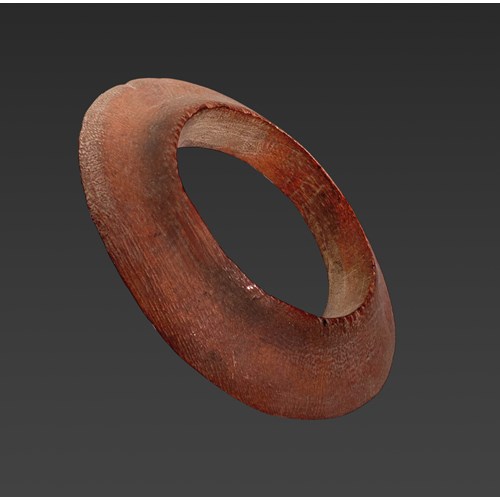Marketplace
MAST FORK
This fork is of special interest in that it was carved on Egum islet where there is no canoe-carving tradition - the islet, situated in the center of Egum Atoll, is so small that the people must purchase their canoes from the large neighboring islands. This fork is the replacement for the deficient original fork delivered with the canoe. This may explain the atypical face and animated attitude of the stylized human figure which this fork represents. Only three mast-forks of this type were thought to be in collections outside of New Guinea as of 1987.
An extremely rare mast-fork or sawasu from an ocean-going canoe. The fork is used horizontally to support the single, free-stepped mast and keep it upright. It also serves as the stanchion for the sail hoist-rope. The “ears” of the figure are used as cleats for the tying-off of the halyard.
Egum Islet, Egum Atoll, Massim Area, Papua New Guinea, Melanesia. Wood with a weathered maritime patina and functional rubbing and wear. 139,5 x 34 cm. Early to mid 20th century.
An extremely rare mast-fork or sawasu from an ocean-going canoe. The fork is used horizontally to support the single, free-stepped mast and keep it upright. It also serves as the stanchion for the sail hoist-rope. The “ears” of the figure are used as cleats for the tying-off of the halyard.
Egum Islet, Egum Atoll, Massim Area, Papua New Guinea, Melanesia. Wood with a weathered maritime patina and functional rubbing and wear. 139,5 x 34 cm. Early to mid 20th century.
Provenance: Provenance : Collected on Egum Islet by Dr. Harry Beran and Anthony JP Meyer, January/February 1987.
Literature: Illustrated :
LE PAYS MASSIM. Galerie Meyer, Paris. 1987, N°1 of the catalogue.
OCEANIE, ART DE L'OCEANIE. Galerie Meyer, Paris. 1988, N° 17, p. 23 of the catalogue.
Meyer, Anthony JP: OCEANIC ART / OZEANISCHE KUNST / ART OCEANIEN. Könemann Verlag, Köln. 1995, Fig. 128, page 138/139.
Frieze Masters 2013, London. Galerie Meyer, Paris. 2013, N° 1 of the catalogue.
Plus d'œuvres d'art de la Galerie









